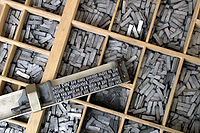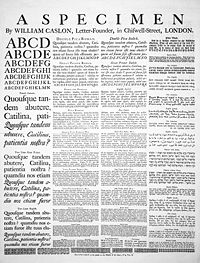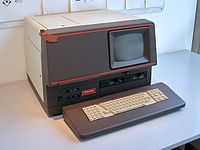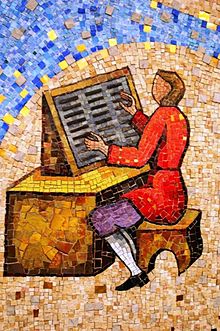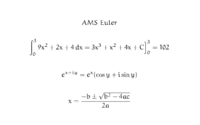- Typesetting
-
Typesetting is the composition of text by means of types.[1]
Typesetting requires the prior process of designing a font and storing it in some manner. Typesetting is the retrieval of the stored letters (called sorts in mechanical systems and glyphs in digital systems) and the ordering of them according to a language's orthography for visual display.
Contents
Letterpress era
During the letterpress era, moveable type was composed by hand for each page. Cast metal sorts were composited into words and lines of text and tightly bound together to make up a page image called a forme, with all letter faces exactly the same height to form an even surface of type. The forme was mounted in a press, inked, and an impression made on paper.
The diagram at right illustrates a cast metal sort: a face, b body or shank, c point size, 1 shoulder, 2 nick, 3 groove, 4 foot. Wooden printing sorts were in use for centuries in combination with metal type.
Copies of formes were cast when anticipating subsequent printings of a text, freeing the costly type for other work. In this process, called stereotyping, the entire forme is pressed into a fine matrix such as plaster of Paris or papier mâché called Flong to create a positive, from which the stereotype forme was cast of type metal.
Hand composing was rendered commercially obsolete by continuous casting or hot-metal typesetting machines such as the Linotype machine and Monotype at the end of the 19th century. The Linotype, invented by Ottmar Mergenthaler, enabled one machine operator to do the work of ten hand compositors by automating the selection, use and replacement of sorts, with a keyboard as input. Later advances such as the typewriter and computer would push the state of the art even farther ahead. Still, hand composition and letterpress printing did not fall completely out of use, and since the introduction of digital typesetting, it has seen a revival as an artisanal pursuit. However, it is a very small niche within the larger typesetting market.
Phototypesetting
Phototypesetting or "cold type" systems first appeared in the early 1960s and rapidly displaced continuous casting machines. These devices consisted of glass disks (one per font) that spun in front of a light source which selectively exposed characters onto light-sensitive paper. Originally they were driven by pre-punched paper tapes. Later they were hooked up to computer front ends.
One of the earliest electronic photocomposition systems was introduced by Fairchild Semiconductor. The typesetter typed a line of text on a Fairchild keyboard that had no display. To verify correct content of the line it was typed a second time. If the two lines were identical a bell rang and the machine produced a punched paper tape corresponding to the text. With the completion of a block of lines the typesetter fed the corresponding paper tapes into a phototypesetting device which mechanically set type outlines printed on glass sheets into place for exposure onto a negative film. Photosensitive paper was exposed to light through the negative film, resulting in a column of black type on white paper, or a galley. The galley was then cut up and used to create a mechanical drawing or paste up of a whole page. A large film negative of the page is shot and used to make plates for offset printing.
Digital era
The next generation of phototypesetting machines to emerge were those that generated characters on a Cathode ray tube. Typical of the type were the Alphanumeric APS2 (1963),[2] IBM 2680 (1967), I.I.I. VideoComp (1973?), Linotron 202 (1978),[3] and Autologic APS5 (1980?). These machines were the mainstay of phototypesetting for much of the 1970s and 1980s. Such machines could be 'driven online' by a computer front-end system or take their data from magnetic tape. Type fonts were stored digitally on conventional magnetic disk drives.
Computers excel at automatically typesetting documents. Character-by-character computer-aided phototypesetting was in turn rapidly rendered obsolete in the 1980s by fully digital systems employing a raster image processor to render an entire page to a single high-resolution digital image, now known as imagesetting.
The first commercially successful laser imagesetter, able to make use of a raster image processor was the Monotype Lasercomp. ECRM, Compugraphic (later purchased by Agfa) and others rapidly followed suit with machines of their own.
Early minicomputer-based typesetting software introduced in the 1970s and early 1980s such as Datalogics Pager, Penta, Miles 33, Xyvision, troff from Bell Labs, and IBM's Script product with CRT terminals, were better able to drive these electro-mechanical devices, and used text markup languages to describe type and other page formatting information. The descendants of these text markup languages include SGML, XML and HTML.
The minicomputer systems output columns of text on film for paste-up and eventually produced entire pages and signatures of 4, 8, 16 or more pages using imposition software on devices such as the Israeli-made Scitex Dolev. The data stream used by these systems to drive page layout on printers and imagesetters led to the development of printer control languages such as Adobe Systems PostScript and Hewlett-Packard's HP PCL.
 Text typeset in Iowan Old Style roman, italics and small caps, optimised at approximately 10 words per line, typeface sized at 14 points on 1.4 x leading, with 0.2 points extra tracking. Extract of an essay by Oscar Wilde The Renaissance of English Art ca. 1882.
Text typeset in Iowan Old Style roman, italics and small caps, optimised at approximately 10 words per line, typeface sized at 14 points on 1.4 x leading, with 0.2 points extra tracking. Extract of an essay by Oscar Wilde The Renaissance of English Art ca. 1882.
Before the 1980s, practically all typesetting for publishers and advertisers was performed by specialist typesetting companies. These companies performed keyboarding, editing and production of paper or film output, and formed a large component of the graphic arts industry. In the United States these companies were located in rural Pennsylvania, New England or the Midwest where labor was cheap, and paper produced nearby, but still within a few hours' travel time of the major publishing centers.
In 1985, desktop publishing became available, starting with the Apple Macintosh, Aldus PageMaker (and later QuarkXPress) and PostScript. Improvements in software and hardware, and rapidly-lowering costs, popularized desktop publishing and enabled very fine control of typeset results much less expensively than the minicomputer dedicated systems. At the same time, word processing systems such as Wang and WordPerfect revolutionized office documents. They did not, however, have the typographic ability or flexibility required for complicated book layout, graphics, mathematics, or advanced hyphenation and justification rules (H and J).
By the year 2000 this industry segment had shrunk because publishers were now capable of integrating typesetting and graphic design on their own in-house computers. Many found that the cost of maintaining high standards of typographic design and technical skill made it more economical to out-source to freelancers and graphic design specialists.
The availability of cheap, or free, fonts made the conversion to do-it-yourself easier but also opened up a gap between skilled designers and amateurs. The advent of PostScript, supplemented by the PDF file format, provided a universal method of proofing designs and layouts, readable on major computer and operating systems.
SCRIPT variants
IBM created and inspired a family of typesetting languages with names that were derivatives of the word "SCRIPT". Latter versions of SCRIPT included advanced features such as automatic generation of a table of contents and index, multi-column page layout, footnotes, boxes, automatic hyphenation and spelling verification.[4]
NSCRIPT was a port of SCRIPT to OS and TSO from CP-67/CMS SCRIPT.[5]
Waterloo Script was created at the University of Waterloo later.[6] One version of SCRIPT was created at MIT and the AA/CS at UW took over project development in 1974. The program was first used at UW in 1975. In the 1970s, SCRIPT was the only practical way to word process and format documents using a computer. By the late 1980s, the SCRIPT system had been extended to incorporate various upgrades.[7]
The initial implementation of SCRIPT at UW was documented in the May 1975 Issue of the Computing Centre Newsletter which noted some the advantages of using SCRIPT:
a) Footnotes are handled easily.
b) Page numbers can be in Arabic or Roman numerals, and can appear at the top or bottom of the page, in the centre, on the left or on the right, or even-numbered pages and on the right for odd-numbered pages.
c) Underscoring or over striking can be made a function of SCRIPT, thus uncomplicating Editor functions.
d) SCRIPT files are regular OS databases or CMS files.
e) Output can be obtained on the printer, or at the terminal…” The article also pointed out that SCRIPT had over 100 commands to assist in formatting documents, though 8 to 10 of these commands were sufficient to complete most formatting jobs. Thus SCRIPT had many of the capabilities that computer users generally associate with contemporary word processors.[8]
SCRIPT/VS was a SCRIPT variant developed at IBM in the 1980s.
Script is still available from IBM as part of the Document Composition Facility for the z/OS operating system.[9]
SGML and XML systems
SGML (the Standard Generalized markup Language) was based upon GML (IBM Generalized Markup Language). GML was a set of macros on top of IBM Script.
The arrival of SGML/XML as the document model made other typesetting engines popular. Such engines include RenderX's XEP, Datalogics Pager, Penta, Miles 33's OASYS, Xyvision's XML Professional Publisher (XPP), FrameMaker, Arbortext, YesLogic's Prince, QuarkXPress and Adobe InDesign. These products allow users to program their typesetting process around the SGML/XML with the help of scripting languages. Some of them, such as Arbortext Editor and XMetaL Author, provide attractive WYSIWYG-ish interfaces with support for XML standards and Unicode to attract a wider spectrum of users.
Troff and successors
During the mid-1970s Joseph Ossanna, working at Bell Laboratories, wrote the troff typesetting program to drive a Wang C/A/T phototypesetter owned by the Labs; it was later enhanced by Brian Kernighan to support output to different equipment such as laser printers and the like. While its use has fallen off, it is still included with a number of Unix and Unix-like systems and has been used to typeset a number of high-profile technical and computer books. Some versions, as well as a GNU work-alike called groff, are now open source.
TeX and LaTeX
The TeX system, developed by Donald E. Knuth at the end of 70s, is another widespread and powerful automated typesetting system that has set high standards, especially for typesetting mathematics. TeX is considered fairly difficult to learn on its own, and deals more with appearance than structure. The LaTeX macro package written by Leslie Lamport at the beginning of the 80s offered a simpler interface, and an easier way to systematically encode the structure of a document. LaTeX markup is very widely used in academic circles for published papers and even books. Although standard TeX does not provide an interface of any sort there are programs that do. These programs includes Scientific Workplace, TeXmacs which are WYSIWYG editors and LyX which is a WYSIWYM editor.
See also
- Composing stick
- Dingbat
- Hot metal typesetting
- Justification (typesetting)
- Ligature (typography)
- Printing
- Printing press
- Sort (typesetting)
- Strut (typesetting)
- Technical writing
- Typeface
- Typography
- Widows and orphans
- MathMagic - Mathematical Typesetting software for Technical writers. Works with Adobe InDesign, QuarkXPress, and word processors.
References
- ^ Dictionary.com Unabridged. Random House, Inc. 23 December 2009. Dictionary.reference.com
- ^ Encyclopedia of Computer Science and Technology, 1976
- ^ Linotype History
- ^ U01-0547, "Introduction to SCRIPT," is available through PRTDOC.
- ^ SCRIPT 90.1 Implementation Guide, June 6, 1990
- ^ CSG.uwaterloo.ca
- ^ A Chronology of Computing at The University of Waterloo
- ^ Glossary of University of Waterloo Computing Chronology
- ^ IBM Document Composition Facility (DCF)
External links
- Metal Type - For Those who Remember Hot Metal Typesetting
- TeX Users Group
- The Lout Document Formatting System
- XML page at www.W3C.org
- SGML page at www.xml.org
- TYPESET-8, the first low cost computerized type setting system
- History of typesetting's practice and typesettings services online
- [1] Typesetting in the 1960 era.
- Typesetting and Desktop Publishing Information
Copy preparation Submission: author or literary agent – Publisher's reader – Contract negotiation: intellectual property rights and royalty rates, format, etc – EditingPrepress Book production Typography terminology Page 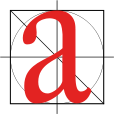
Paragraph Character Typeface anatomyCounter · Diacritics · Dingbat · Glyph · Initial · Kerning · Letter-spacing · Ligature · Subscript and superscript · Swash · Text figuresCapitalizationVertical aspectsClassifications Punctuation Typesetting Calligraphy · ETAOIN SHRDLU · Font (Computer font) · Font catalog · Letterpress · Lorem ipsum · Movable type · Pangram · Phototypesetting · Punchcutting · Type design · Typeface · Type foundry · MicrotypographyTypographic units Digital typography Categories:
Wikimedia Foundation. 2010.

